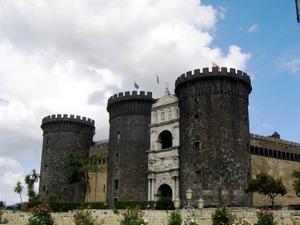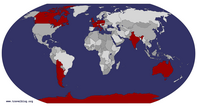Advertisement
Published: October 30th 2006

 Castel Nuovo in Napoli
Castel Nuovo in Napoli
Close by to our accommodationBudapest - Vienna - Rome - Naples (Train)
26-28 August Napoli is our first glimpse of the real, un-touristy Italy, and ever since we’ve arrived I’ve had Dean Martin’s “That’s Amore” running through my head.
“In Napoli where love is king, When boy meets girl here's what they say… dee de-de, dee de-de, dee de-de…When the moon hits your eye like a big pizza pie, That’s amore.” It’s the fabled home of pizza, and tasting some of the local fare is high on our agenda (yes, even mine!), it’s also the closest stop to Pompeii, a place I’ve wanted to see since I was a kid after watching “Great Mysteries of the World” on Sunday nights. What we didn’t know is that it’s also the home to the craziest drivers in Italy.
As soon as we step out of the train station we are almost hit a number of times by cars, vespas and buses as we walked tentatively over the pedestrian crossing towards the local buses. Once on the bus we are able to watch, in relative safety, as the traffic cuts, weaves and speeds around the bus with complete abandon. There are often 3

 Pompei
Pompei
Mt Vesuvius lies dormant but still threatening in the backgoundpeople to a vespa (or mopeds), none of whom are wearing a helmet, cutting and speeding their way through traffic. A very unpopular law was passed in Italy in 2000 making it compulsory for all to wear helmets on motorbikes, motorinos, vespas and bicycles, but what the politicians didn’t count on is the Italian propensity to disregard any law they see as unimportant or as a restriction on their civil liberties - in Napoli only about 30% seem to be wearing helmets. If they are wearing helmets, they are usually undone, or at best tied up but sitting at the back of their head so as to not mess up the hair. The most incredible example I saw were two guys on a vespa with the driver steering with one hand, wildly gesturing with the other hand all while turned around towards his passenger shouting a conversation. No helmet, and no idea where he was steering. Porca Madonna! It is true though, that one can never look as chic with a helmet on, imagine Audrey Helpburn in Roman Holiday with a helmet - it’s just not the same.
We find our hotel behind two tall wooden doors facing the
street, through a courtyard and up 6 flights of stairs. Our room is big, quiet, cool and only a stumble away from 6 pizza restaurants and the Castel Nuovo on the harbour - primo! Before dinner we decide to go for a walk around the local area to get a taste of Napoli and build up our appetite. We wander past the stoic Castel Nuovo, through the Teatro San Carlo with its beautiful glass roof and towards the piazza Plebiscito where you get to see both the Palazzo Reale and hazy views of Mount Vesuvius across the harbour - ahh, bella vista! As it’s Sunday afternoon we see many Italians strolling around arm in arm, or sitting on benches, chatting in groups looking very chic, and oh so nonchalant. There are also some nonnas out with their black house dresses hoicked up over their knees to catch he breeze who are less chic, but more chatty and smile at us when we walk by. We pick one of the local pizza restaurants nearby our hotel and sit down to dinner at the very un-Italian time of 7.30. We have enjoyed our dinner of antipasti and calzone (with mozzarella, ruccola and

 Pompei Plaster Cast
Pompei Plaster Cast
Plaster of paris was poured into cavities found during excavation to show how quickly residents were etombed by the falling ash. Eerie detail!prosciutto - delicious!) washed down with a bottle of cool, light, local white wine before most of the locals start to roll in. We cannot fit in dessert and the staff, aghast that we would not be finishing our meal with something sweet to assist in our digestion, bring us each a nip of aperol (apple spirit), on the house, to both satisfy our proper digestion and their conscious.
”When the world seems to shine like you've had too much wine, That's amore!” The next day we wake up, headache free and properly digested for our morning of exploring the famous World Heritage ruins of Pompeii. The city was destroyed during a huge eruption of the volcano Mount Vesuvius in AD 79. The volcano buried the city under meters of ash and it was lost for over 1,600 years before its accidental rediscovery in 1748. Since then, Pompeii has been progressively excavated to reveal many intact buildings and wall paintings. Unfortunately, allot of the original paintings and mosaics have been taken out and replaced with replicas. But as you wander through some of the palatial homes, with their rooms fronting onto gardens and fountains you do get a sense of what it was like to be rich in Roman times. At the other end of the spectrum the frescos in some of the smaller houses with many bedrooms give you more of an idea of what you could request when visiting these establishments. It’s amazing to see that human nature hasn’t changed much over thousands of years; on the walls in this brothel you can still read the graffiti of some of the visitors boasting of their accomplishments. Romeo et al??
The other well known finds out of Pompeii are the plaster-casts of the people trapped in the city during the eruption. This is mainly thanks to the foresight of Giuseppe Fiorelli. When he took charge of the excavations in 1860, his excavators alerted him to some voids in the ash layer had been found that contained human remains. It was Fiorelli who realised these were spaces left by the decomposed bodies and devised the technique of injecting plaster into them to perfectly recreate the forms of Vesuvius's victims. What resulted are highly accurate and eerie forms of the doomed Pompeiani who failed to escape, with their bodies contorted and the expression of terror clearly left on their faces. There are few of these plaster casts on display throughout the ruins - Tim was absolutely fascinated by them, I have to admit to being a little unsettled by them.
Most of the recovered artifacts are now found in the Museo Nationale back in Napoli. It’s a huge museum filled with many of the treasures collected from Pompeii and nearby Herculaneum (also buried by Vesuvius). It has some of the finest mosaics I have ever seen; both huge showing battles in great detail or small with the tiniest pieces of stone used to represent the face of some long lost Pompeiani. One of the other things this museum is known for is its “secret cabinet” containing erotic artifacts. Ancient Roman culture of the time was much more liberal than most present-day cultures, although much of what might seem to us to be erotic imagery (eg oversized phalluses) was in fact fertility-imagery. This clash of cultures led to an unknown number of discoveries being hidden away. In 1819, when King Francis I of Naples visited the Pompeii exhibition at the National Museum with his wife and daughter, he was so embarrassed by the erotic artwork that he decided to have it locked away in a secret cabinet, accessible only to "people of mature age and respected morals". Re-opened, closed, re-opened again and then closed again for nearly 100 years, it was briefly made accessible again at the end of the 1960s (the time of the sexual revolution) and was finally re-opened for viewing in 2000.
The late afternoon we spent lazily wandering around the many winding streets, popping into old churches, and devouring some wonderfully cool gelato, before stocking up on some antipasti and a bottle of Chianti for our return back to the hotel for a picnic dinner.
When you walk down in a dream but you know you're not dreaming, signore…scuzza me, but you see, back in old Napoli - That's amore” Before we leave the next morning for Rome, we head to the local “bar” for our breakfast. Most Italians slam down their breakfast in under a minute in one of these places before heading off to work. After a couple of mornings in Italy, we are now aficionados in this practice, and casually saunter in with our “bon giorno” and call out “duo expressi e duo choco-brioche - gracie!” with the appropriate hand signals (our Italian isn’t that good yet). We don’t quite get it all down in a minute, but we are out after 5. The coffee is the sort of stuff that blows your head off but still has the most luscious crema, and the choco-brioche is not quite chocolate but filled with gooey nutella.
Now that’s amore.
L
Advertisement
Tot: 0.19s; Tpl: 0.011s; cc: 17; qc: 70; dbt: 0.0506s; 1; m:domysql w:travelblog (10.17.0.13); sld: 1;
; mem: 1.2mb










Haggis
non-member comment
An old saying
Your partially oblique reference to the brothels of Pompeii reminds me that the via in which the (25) Pompeiian brothels (lupinare) were located - now called the Vico del Lupinare - was the only curved street in Pompeii. All the other streets were straight. The reason they were straight was that chariots had no diffs (differential gears) and could only go straight or turn over a fairly wide arc - wider than a street. There were no chariots in the brothel street (a) because it was curved and (b) because customers like the famed and aptly named Scordopordonicus did not want to be identified by having their chariots parked outside the brothels!! Hence, the origin of the wives' saying to husbands: "Did you come straight home?" (e.g. from work). Since some bars, baths and a small theatre were also co-located in the Vico del Lupanare, on the only curved street in town, it followed that any husband who hadn't come straight home must have been in the Vico del lupanare and up to no good. You learn something every day.